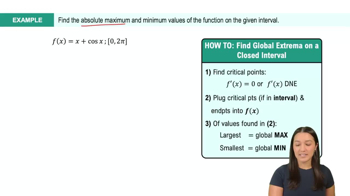Here are the essential concepts you must grasp in order to answer the question correctly.
Symmetry in Intervals
An interval is symmetric about a point if the distances from that point to the endpoints of the interval are equal. For an interval (a, b) to be symmetric about x = c, it must hold that c - a = b - c. This means that the midpoint of the interval must coincide with the point of symmetry.
Recommended video:
Endpoints of an Interval
The endpoints of an interval are the values that define the limits of the interval. For example, in the interval (a, b), 'a' is the left endpoint and 'b' is the right endpoint. Understanding the endpoints is crucial for determining the symmetry of the interval about a specific point.
Recommended video:
Finding Global Extrema (Extreme Value Theorem) Example 4
Calculating Midpoints
The midpoint of an interval (a, b) can be calculated using the formula (a + b) / 2. This value represents the center of the interval and is essential for assessing symmetry. If the midpoint does not equal the point of symmetry, the interval is not symmetric about that point.
Recommended video:
Determining Error and Relative Error Example 1
 Verified step by step guidance
Verified step by step guidance Verified video answer for a similar problem:
Verified video answer for a similar problem:



 6:47m
6:47m